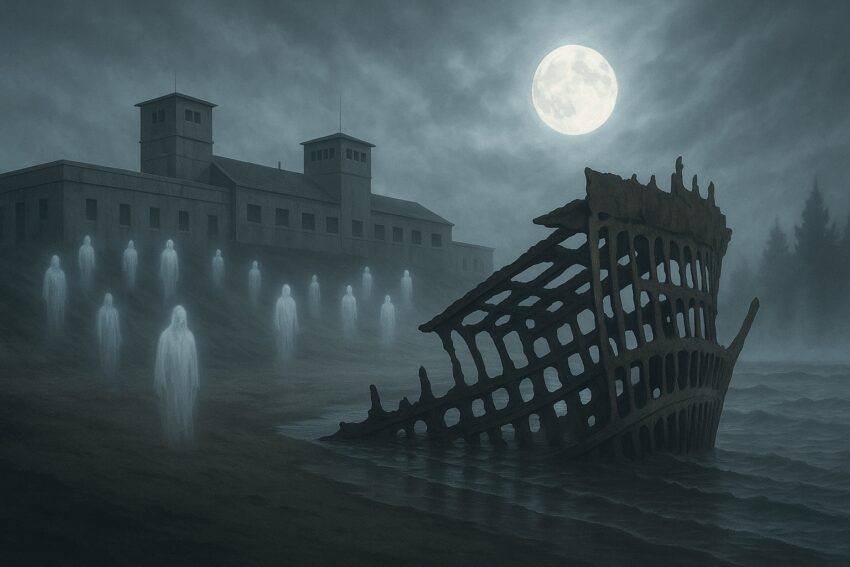
The Hauntings Of Fort Stevens & The Graveyard Coast
Between the crashing waves and rusting bones of ships long forgotten, something lingers on the sands of Fort Stevens. Get the spooky scoop after the jump.
Note: Most of the ghosts and ghost stories in this article could be classified as urban legends. There are little-to-no historical records or published reports to support the claims. BUT … they are spooky fun.
Table of contents
🌊 A Deadly Coastline with a History That Won’t Stay Buried
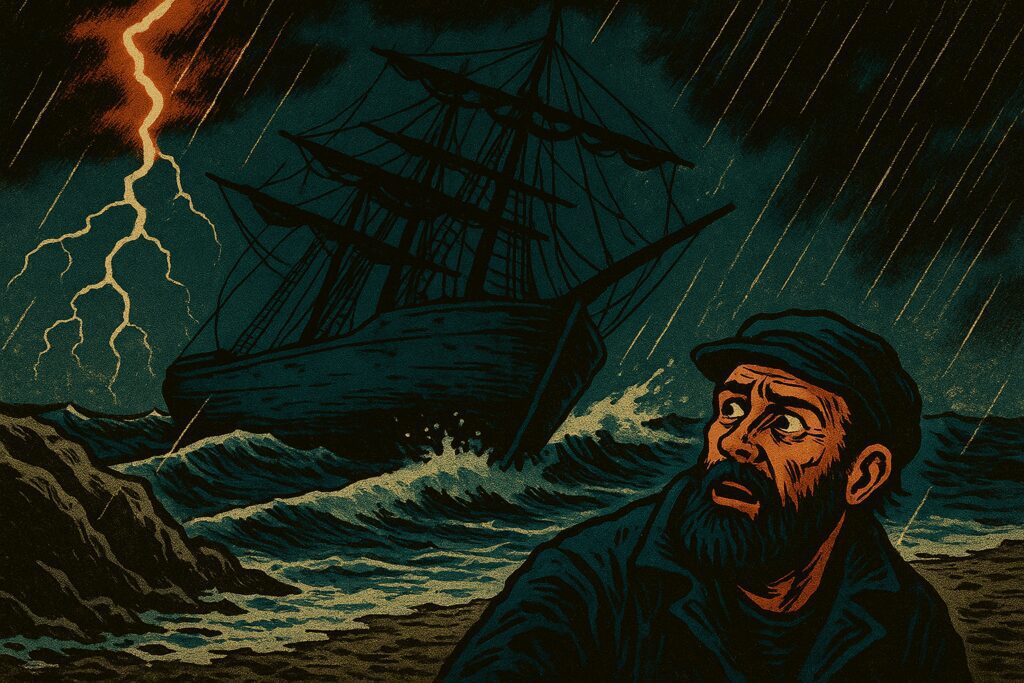
The Oregon coast near Astoria has many names, but none chill the spine quite like “The Graveyard of the Pacific.” More than 2,000 ships have wrecked here since the 1700s. And Fort Stevens, once a mighty military post guarding the Columbia River, sits right at the heart of it.
Today, it’s a peaceful state park with campsites, hiking trails, and history tours. But after dark, the winds shift. Whispers rise. Lights flicker in the mist.
And the spirits of drowned sailors aren’t as quiet as you’d hope.
⚓ The Wreck of the Peter Iredale
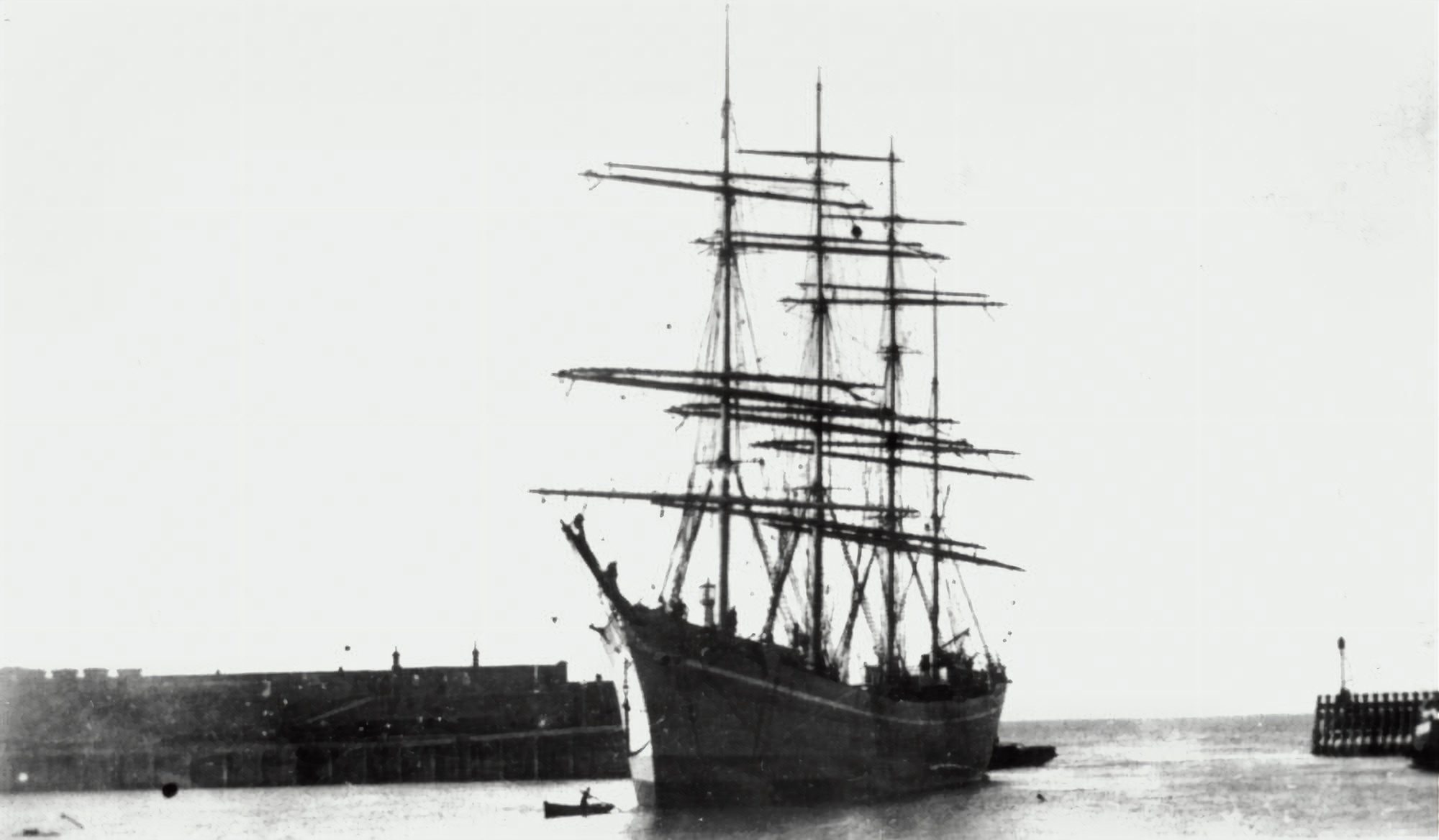
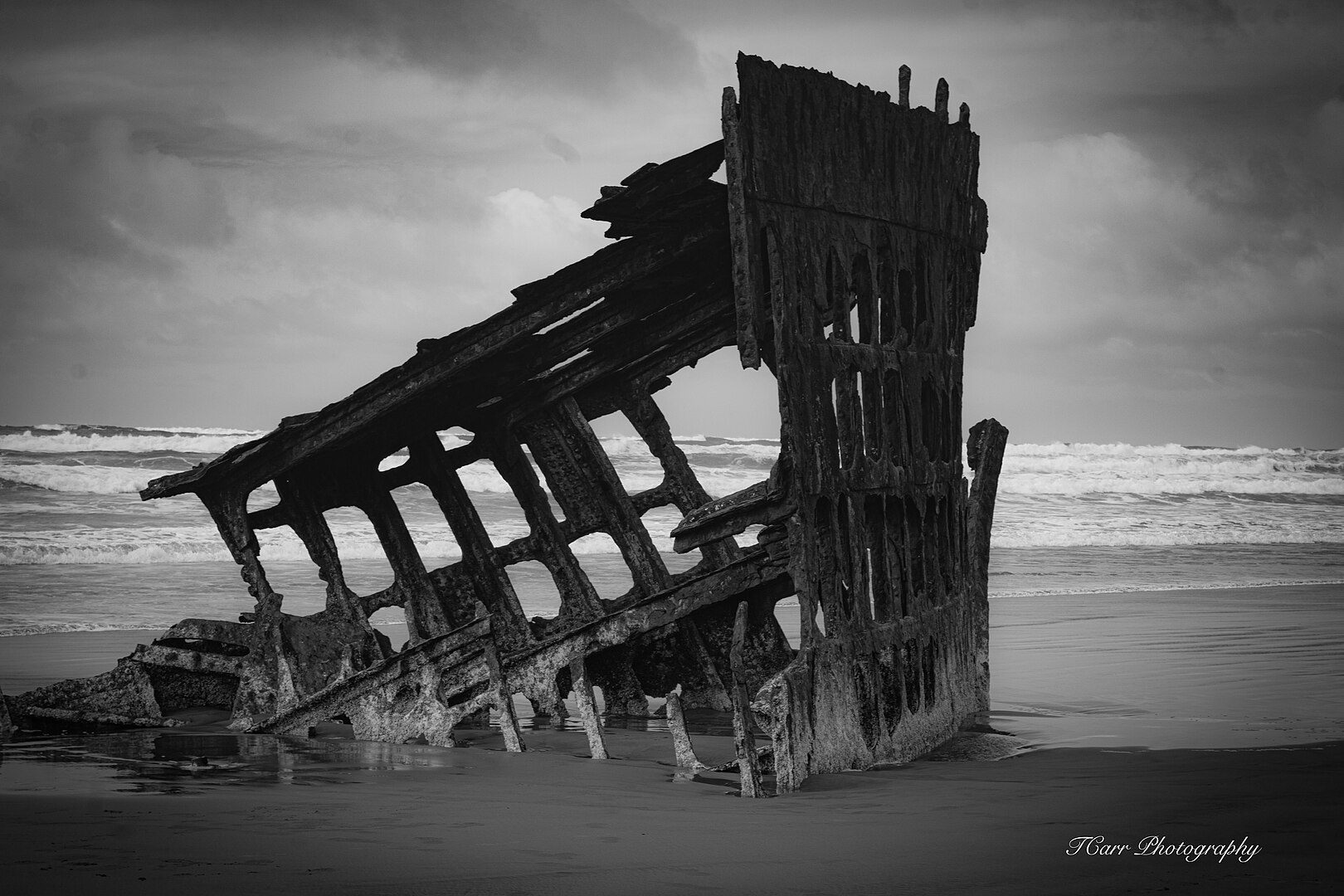
It was the early morning of October 25, 1906. A fierce squall rolled over the Pacific, blackening the sky and lashing the decks of the Peter Iredale, a four-masted steel barque en route to the Columbia River. Captain H. Lawrence and his crew had already weathered a long and grueling voyage from Mexico. But now, just miles from their destination, they found themselves at the mercy of the Columbia Bar—a place sailors feared more than pirates.
The wind howled as the waves surged higher, pounding the hull with relentless force. Visibility dropped to near zero. The captain ordered the anchor dropped, but it was too late. The Peter Iredale was caught by the surf and driven straight onto the unforgiving Oregon coast.
When daylight finally broke, the wreck was wedged deep in the sands, its masts shattered, its hull groaning with each retreating wave. Remarkably, all 27 crew members were rescued. Newspapers called it a miracle.
But local lore tells a different version.
The Young Sailor Spirit
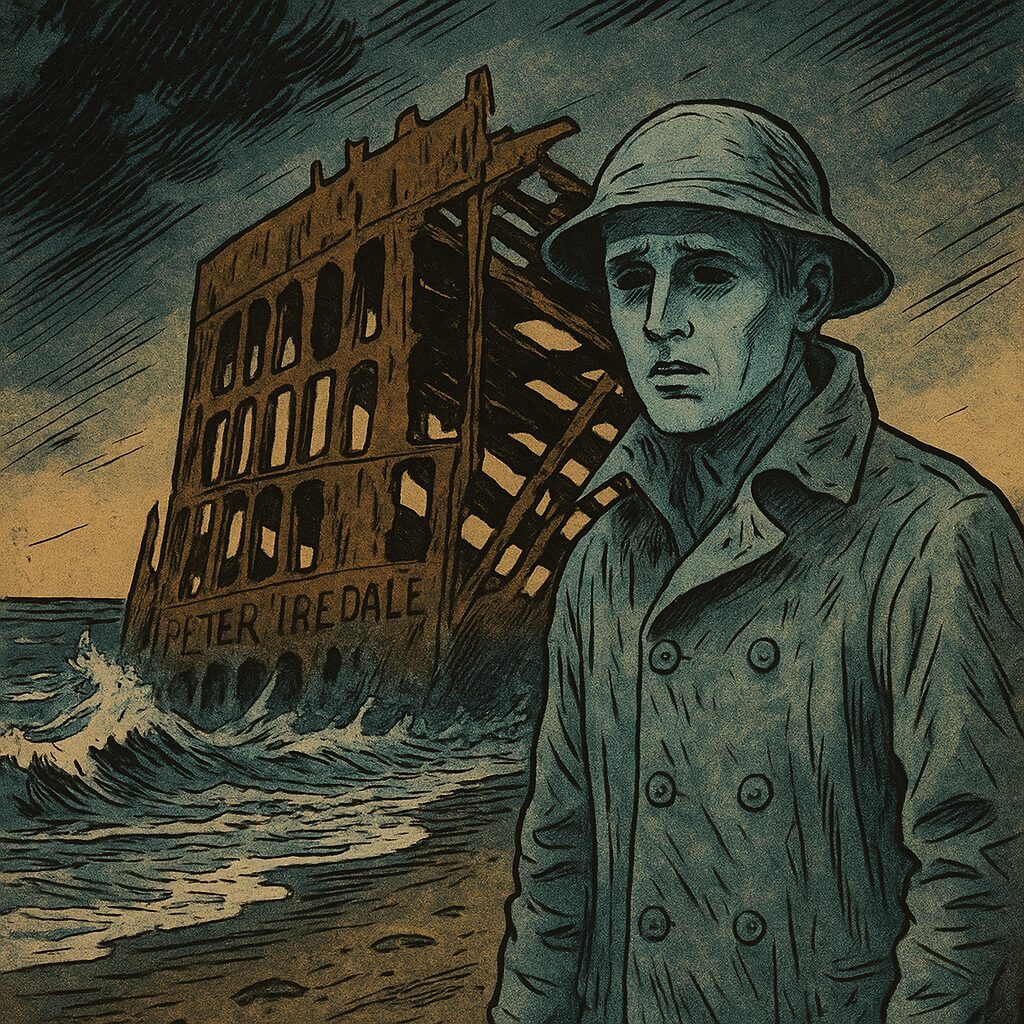
You’ve probably seen the rusted iron ribs of the Peter Iredale jutting out of the sand like a skeletal warning. This four-masted sailing ship ran aground in October 1906, just a few miles from the Columbia River Bar, after battling a brutal squall on its way to Portland. All hands survived—officially.
But some say one soul never made it back.
For decades, beachgoers have reported seeing a young sailor in oilskin gear, wandering near the wreck just before sunset. He waves. Sometimes he shouts. But when you get close—he’s gone. No footprints in the sand. No trace at all.
Witnesses describe his look as late-19th to early-20th century: slick black raincoat, wide-brimmed hat, and heavy sea boots. Occasionally, he’s seen climbing the twisted hull, as if inspecting damage, or looking longingly out to sea.
Local legend holds that a sailor named Thomas—or maybe Tim, depending on the telling—was below deck during the ship’s grounding. His body was never recovered. Paranormal researchers have collected EVPs at the wreck that include distant humming and what some say sounds like a voice calling, “All hands…”
Though no historical record confirms a death aboard the Peter Iredale, the sightings persist, even to this day.
🕯️ Ghosts of the Shoreline
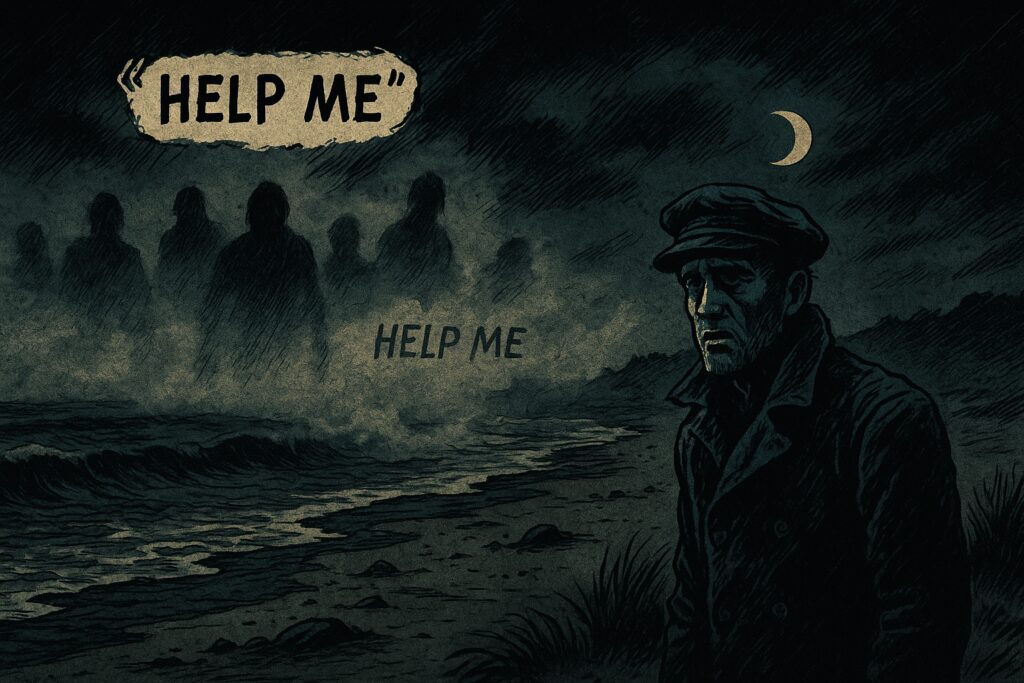
Fort Stevens’ shoreline holds more than shipwrecks—it holds voices, shadows, and mysteries no wind or tide can wash away.
Many have heard phantom cries for help coming from the surf, especially in fog or stormy weather. The voices are faint but urgent, and witnesses often describe a sense of panic or dread as if someone is drowning just offshore. There’s never anyone there.
Paranormal teams have staked out the beach with night vision cameras, audio recorders, and EMF detectors. Several have captured chilling evidence:
- EVPs (electronic voice phenomena) with cries like “Man overboard!” or “Still sinking!”
- Thermal imaging hits that show human-like figures wading through the waves
- EMF spikes recorded near the tideline despite the absence of electronics or power sources
- Disembodied footsteps heard circling investigators in the sand, even when wind and surf are quiet
There’s even a legend of a vanished rescue boat. Locals claim a small lifeboat was once dispatched to recover a survivor from a wreck, only to vanish without a trace. Neither boat nor crew were ever found. Some say the cries are theirs, repeating forever.
On especially foggy nights, beachgoers have reported seeing a dim green lantern bobbing just beyond the waves—too far to reach, too clear to ignore.
🪖 Battery Russell and the Ghost Soldiers
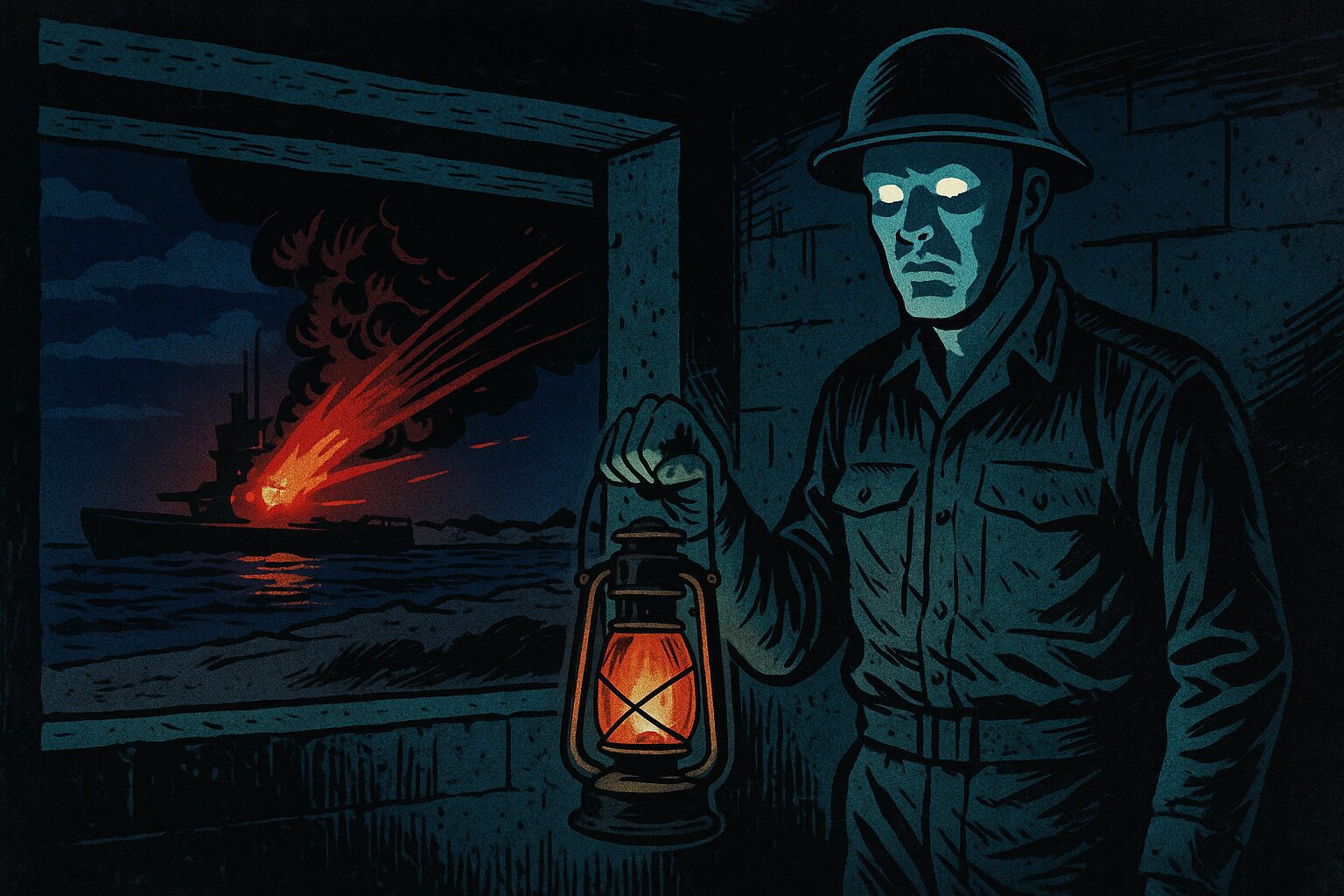
Fort Stevens saw real combat during World War II. On the night of June 21, 1942, the Japanese submarine I-25 surfaced off the Oregon coast and began firing its deck gun at the fort. Around 16 shells were launched toward Battery Russell and surrounding areas. Alarms blared, soldiers scrambled to their posts, and spotlights swept the ocean.
Amazingly, no one was killed and the fort suffered only minor damage—but the psychological impact was immense. It marked the first time since the War of 1812 that a foreign power had fired on a military installation in the continental United States.
What followed, according to some, is where the hauntings begin. A young radar operator reportedly died of a heart attack that night from the shock. Others swear they’ve seen his spirit still working the bunker radios. Visitors to Battery Russell have reported hearing distant cannon fire, boots running on concrete, and a low voice repeating, “target acquired… fire.”
This brief but terrifying moment left a permanent scar—both on the landscape and, some say, in the veil between the living and the dead.
Today, those same bunkers and batteries are haunted by the ghosts of soldiers still on duty.
Hikers report the scent of gunpowder, the crack of phantom rifle fire, and a lone watchman pacing with a lantern in hand. If you call out, he doesn’t turn. He just keeps walking.
And then he’s gone.
🚢 Why So Many Spirits?
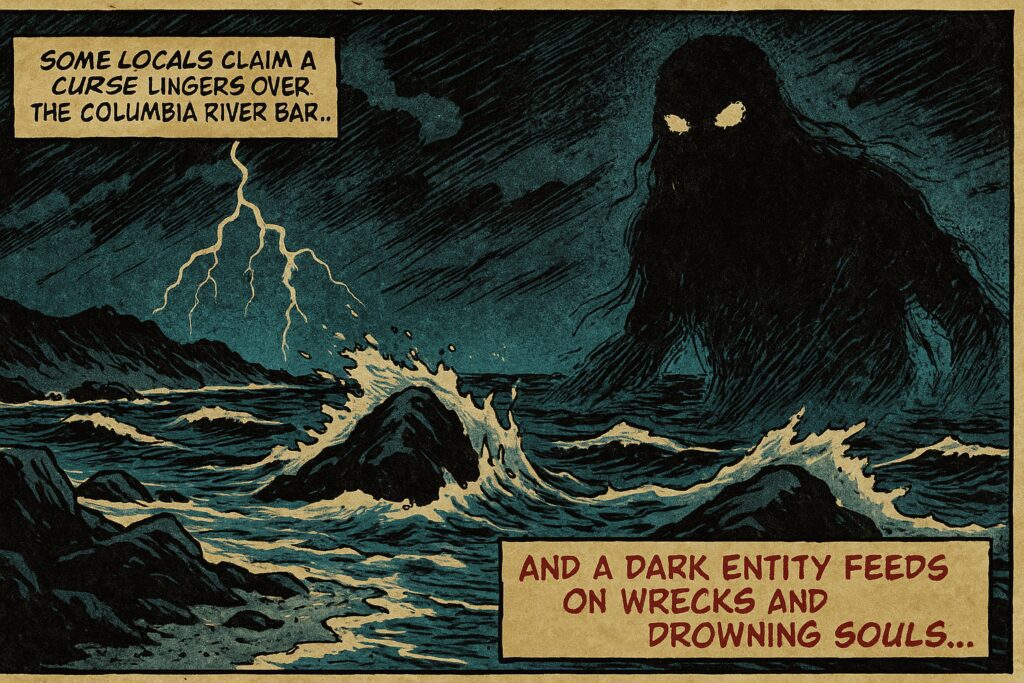
The Columbia River Bar—where fresh river water slams into the Pacific Ocean—is deadly. Shifting sandbars, strong tides, and violent weather have turned this spot into a sailor’s nightmare. It’s claimed more ships than nearly any other coastal location in North America.
But there are whispers of something darker.
Some say a curse was placed here by coastal tribes long ago, as a ward against invaders and spirits from the sea. Others believe the violent energy comes from all the blood and steel lost to the ocean—a kind of supernatural fuel. Over the years, shipwrecks, drownings, and wartime casualties have layered the ground with sorrow.
More than just restless spirits, some ghost hunters believe a dark entity stalks the Bar. Described as a towering shadow with glowing red eyes, it’s said to rise from the ocean mist when storms peak and waves break violently over the jetty. Witnesses have reported a pressure in the chest, a sudden inability to breathe, or the urge to run before seeing anything. A few psychics claim it feeds off fear and confusion, pulling spirits toward it like a lighthouse of the dead.
Some locals claim the ghosts aren’t trapped—they’re guarding the living from whatever lurks in the depths.
📜 Final Thoughts: Don’t Wander Alone

Fort Stevens is beautiful—but don’t let your guard down at night. Campers have gone missing for hours, later found with no memory of where they’d been. Ghost hunters report EMF spikes on the beach and compasses that spin wildly for no reason.
If you visit, bring a flashlight. Stay near the trails. And if someone in old-fashioned clothes waves at you from the water…
Don’t wave back.
Sources
Oregon Coast Visitors Association. “Shipwreck of Peter Iredale.” Visit the Oregon Coast, https://visittheoregoncoast.com/cities/warrenton/activities/shipwreck-of-peter-iredale/. Accessed 2 May 2025.
“Peter Iredale.” Wikipedia, Wikimedia Foundation, 2 May 2025, https://en.wikipedia.org/wiki/Peter_Iredale.
Oregon State Archives. “Threats and Bombs.” World War II: The Home Front, Oregon Secretary of State, https://sos.oregon.gov/archives/exhibits/ww2/Pages/threats-bombs.aspx. Accessed 2 May 2025.
“Haunted Fort Stevens.” Portland Ghosts, https://portlandghosts.com/haunted-fort-stevens/. Accessed 2 May 2025.
That Oregon Life. “The Eerie Tale of a Ghostly Soldier at Fort Stevens in Oregon.” That Oregon Life, 9 Oct. 2024, https://thatoregonlife.com/2024/10/the-eerie-tale-of-a-ghostly-soldier-at-fort-stevens-in-oregon/. Accessed 2 May 2025.
“Fort Stevens.” Oregon Encyclopedia, https://www.oregonencyclopedia.org/articles/fort_stevens/. Accessed 2 May 2025.
“Shipwrecks in Oregon.” Oregon Encyclopedia, https://www.oregonencyclopedia.org/articles/shipwrecks-in-oregon/. Accessed 2 May 2025.
Oberding, Janice. “Ghost Soldiers of Fort Stevens.” The Big Book of Oregon Ghost Stories, Globe Pequot, 2022.
Linskey, Annie. “I Believe in the Possibility of Ghosts.” Daily Astorian, 29 Aug. 2006, https://dailyastorian.com/2006/08/29/i-believe-in-the-possibility-of-ghosts/. Accessed 2 May 2025.
Gibbs, James A. Pacific Graveyard: A Narrative of Shipwrecks Where the Columbia River Meets the Pacific Ocean. Portland, Oreg., 1964.
Marshall, Don B. Oregon Shipwrecks. Portland, Oreg., 1984.
Wells, R.E., and Victor C. West. A Guide to Shipwreck Sites along the Oregon Coast, via Oregon US 101. R.E. Wells & V.C. West, 1984.
“The Wreck of the Peter Iredale.” Oregon History Project, Oregon Historical Society, https://www.oregonhistoryproject.org/articles/historical-records/the-wreck-of-the-peter-iredale/. Accessed 2 May 2025.
Have you had a spooky experience at Fort Stevens? Let me know in the comments below.
Thanks for reading Ghostly Activities. Much appreciated and take care!
